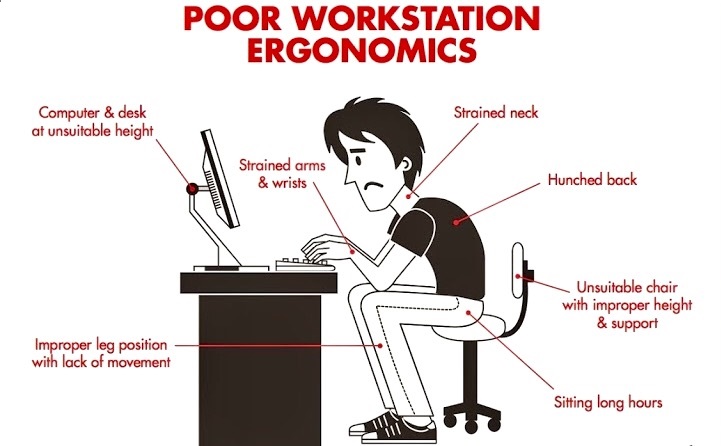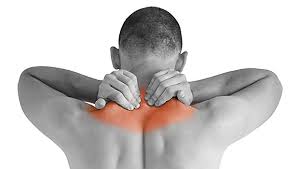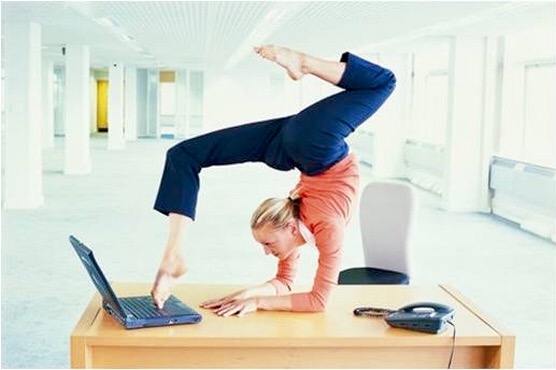WORKPLACE POSTURE AND THE EFFECTS ON YOUR BODY
If you sit at a desk and/or at a computer for most of the working day you are part of the majority, with a Safe Work Australia study reporting 81% of surveyed Australian workers are exposed to sitting as part of their work [1]. Whilst sitting doesn’t seem like a ‘high risk’ activity, the same study reported that respondents suffered from some level of back or neck pain (52%), or shoulder, arm, wrist or hand pain (55%). I’m sure you can vouch for that at the end of a busy work week… that relief knowing you have a few days rest from being confined to a desk and/or chair.
So why does having a sedentary job result in pain and dysfunction?
Whilst there are many and varied reasons for people’s pain, the most common issues in this instance are poor workplace ergonomics and postural deficiencies. Some classic signs of poor posture at the work station include:
– Forward Head Posture, whereby the head is not on top of the shoulders (tight/shortened Upper Trapezius, Levator Scapulae and Sub-Occipitals)
– Exaggerated curve of the upper back (lengthened Rhomboids and Lower Trapezius)
– Rounded shoulders (shortened Pectoralis Major/Minor and Serratus Anterior)
– Exaggerated curve of the Lower Back (lengthened Thoraco-lumbar extensors and shortened hip flexors)
– Feet stretching to make contact with the floor leading to poor stability and muscular imbalances

These postural issues cause pain in the first instance but can also lead to dysfunction due to the effects on the muscles and joints. If muscles are kept in a shortened or lengthened state, or joints are compressed or distracted, for a sustained period they will become aggravated (pain) and no longer perform optimally (dysfunctional).
So, why is this important?
Once the muscles or bony structures become painful and dysfunctional the pain may be felt in the head and face, back or front of the neck, down the shoulders into the arm or hand, down through the back, or even into the buttocks and legs. This pain may be caused by one or many structures in the body and if left untreated can affect productivity, emotional and mental well-being and overall quality of life.

So, what can be done about it?
Ideally, having the option of a sit-stand desk will allow you the flexibility of varying your posture throughout the day but in some cases this isn’t possible. Therefore, arguably the most important change one can make to the work station (if sitting is the only option) is to place a towel or pillow behind the lower back whilst seated and sit right back in the chair. This will, ideally, maintain the natural curve of the lumbar spine (low back) and intrinsically “stack” the rest of the body upright, ensuring a better posture.
In addition, adjusting the height of the work chair and height of the computer screen are both important factors. Ensure that the screen of the computer is at eye level so you do not have to look up or down whilst seated; as this will inevitably lead to a compromised head/neck posture. Also, adjusting the height of your chair so that your feet are flat on the floor will distribute pressure evenly across your feet and legs.
Take more frequent breaks! If you find yourself sitting for 1.5hrs-2hrs this is probably too long! Try and take a break every 30 minutes or so, even if it is just to do a small stretch or to get a drink. This will help you to reset your posture, ensure adequate circulation around your body and, who knows, maybe even refresh you!
Finally, whether you have pain already or want to prevent issues, there are a few simple stretches and exercises that can be performed in the workplace or at your desk to counteract the negative effects of daily sitting:
– Neck: Place your face as if trying to sniff your armpit and with the same hand, place it over the back of your head and pull your head further down, gently. Experiment with the position of this stretch for the best result for you. You should feel the stretch down the back/side of your neck-
– Front of the chest: Find a doorway to make this easiest. Place from your elbow to your hand against the doorframe at approx. shoulder height and take a small step forward. You should begin to feel a stretch across you chest. Again, experiment with this stretch by placing the arm further up or down and stepping farther forward to deepen the stretch.
– Hip Flexor: Kneel on the ground as if you were going to propose to someone. Keep your body upright and see if you feel a stretch. If you do not, try to “tuck” your buttock underneath yourself to increase the stretch. If you find you still want more, try raising the same arm as hip into the air and leaning away from the hip that is being stretched.

What can you do if you still have pain?
If you have improved your work set up and started to do some stretching but still have pain then you should be assessed by a health professional. At Northern Podiatry, Travis, our Myotherapist, can assess and manage a variety of musculoskeletal conditions through manual therapy, joint mobilisations, dry needling and exercise prescription.
To book an appointment with Travis call 94805522 or book online at www.northernpodiatry.com.au
[1] Safe Work Australia. (2011c). National hazard exposure worker surveillance: Exposure to biomechanical demands, pain and fatigue symptoms and the provision of controls in Australian workplaces. Retrieved from Canberra, Australia:J
